|
|
Inquiring Minds Want to Know
A Duckworks reader inquires:
"....My next boat will be a Clarence River Dory by John Welsford..:
...I am thinking of using a classic outboard for the boat
since I don't want to spend 3 grand on a Honda 20 for it. Anyway,
I have a little Honda 2 for emergencies if the old timer fails to
proceed. Any suggestions for something in the 20-30 hp range?"
If you disregard the issue of money, the purchaser of a new outboard
motor has an almost unlimited choice of brands and models of engines
available. It is rarely necessary for the buyer of a new outboard to
make any compromises as to horsepower or features; the buyer can
purchase the exact model outboard that best fits the needs of a particular
boat.
The purchaser of a used outboard, however, has a much more limited
choice of engines available; in effect the purchaser of a used outboard
is limited not only to the choices made by the original purchasers of the
outboards, but also by what particular outboard motors are on the market at
any particular time in a particular area. . The result is that the purchaser
of a used outboard is nothing like the buyer of a new engine. Being less discriminating in
one's requirments will increase the likelyhood of locating a suitable engine.
A 1957 Johnson 18 hp; the first year of 18 production.
Note that this version has electric start; if you want electric
start, be prepared to pay a big premium as any small electric
start outboard is a "high demand" item. A properly-tuned 18
is easy to manually start, anyway. Note the pressurized
fuel tank.
(click images to enlarge) |
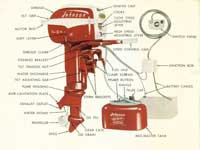 |
|
Although many would consider horsepower to be the first factor in the
selection of an appropriate used outboard, I consider the matter of shaft-length to be more important. As discussed in the shaft length column,
the older an outboard is, the less likely it will be that 20-inch versions will
be available. For engines of under about 25 horsepower, 20-inch engines
are extremely rare except in some areas that have high concentrations of
sail boats, and even in that case the 20-inch versions will most likely be of
under 15 horspower, with "ski boat" outboards of 40 hp and up being most
likely 20 inch versions, leaving most engines of 20 to 35 horse power being of
15 inch versions.
I have only the small-scale drawings of the Clarence River Dory posted on Duckworks to
reference, but it appears to me that the dory is designed to use 20-inch shaft engines*.
The written discription does make mention of "short-shaft" engines, although again
there is the problem of exactly which length is considered a "short shaft" when there
are three lengths available. Perhaps the design can be built either way, but
if one intends to use an outboard manufactured before, say the mid-70's, a 20 inch
version is going to be much harder to locate than a 15 inch version in the 20 to 25
horsepower range.
*John Welsford writes: "The CRD was designed to take a standard short shaft (15in) motor. It can, with very minor change, take up to 25 inches. You can make pretty much anything fit from a 13 in leg two hp motor (gives you about 4 knots with three people) up to a longshaft 40 which will give you a pretty exciting ride!"
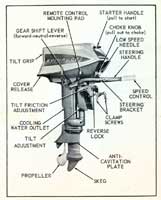 |
This 1965 Evinrude 18 is almost identical to the '57 Johnson 18 above
except for obvious differences such as hood design and paint,
and less obvious differences such as a fuel pump (no pressure
tank) and a fixed high-speed jet in place of the adjustable high-speed needle valve. |
|
I would add that if I were to build this boat with a 15 inch transom, I would make such
provisions so that the transom could be 'built up" to 20 inches at some point in the future.
If I were ever to purchase a new outboard motor of 20 to 25 hp, for use on this or any boat, I would
be inclined to purchase a motor with a 20 inch shaft, as many new boats that use
this size outboard have 20 inch transoms either standard or available, and most
home-built designs can be adapted to use a 20 inch engine.
If the decision is to use a 15 inch engine on the Clarence River Dory, then the next
consideration is the horspower. The designer indicated 25 hp as the maximum for
the craft, and with a wealth of experience running 10 hp and 18 hp engines on my
own 18 foot flat-bottom boat, with a short trial run with a 25 as well, I whole-heartily agree that
25 should be the maximum. The Duckworks plans catalog indicates that the bare
boat should weigh approximately 308 pounds; Knowing that home-boatbuilders
generally "over-build" their boats (me too !) I am going to make a guess at 350 pounds
for the bare boat. Adding outboard, fuel, and gear would bring the weight to about
650 to 700 lbs, depending on the amount of "gear," of course. Add two people and
the boat should weigh in, say, at 900 to 1000 lbs. According to a truck scale, my 18 footer
with all gear aboard but no people weighs right at 1000 lbs, so I believe it to be comparable
to the dory as far as horsepower requirements.
| 1970 Evinrude 18 differs from the 1965 mostly in paint and decals. |
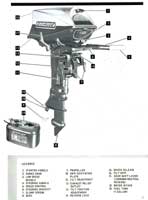 |
|
I have found an 18 hp outboard to be more than adequate for my own boat, and I would
probably be satisfied with 18 hp on a Clarence River Dory as well. As OMC (Outboard
Marine Corp., my outboard motor manufacturer of choice) made
Johnson and Evinrude 18's from 1957 until about 1973, there should be a fairly good
selection of used engines available, although keep in mind that outboards of between
10 and 20 hp are in higher demand by anglers than engines of higher and lower hp,
and so the price may be affected. As 18's were generally too large for sailboat
use, and most powerboats built during that era suitable for 18 hp engines
were built with 15 inch transoms, it will be rare to find a 20 inch version of an 18.
Also keep in mind that 18's built before about 1960 will utilize a pressurized fuel
tank unless converted to a fuel pump.
From about 1969 until the early '70s, Both J. and E. sold a 25 hp version of the
18, but these engines are not seen too often, possibly because the attempt to
extract 25 hp from their 22 cubic inch powerheads overstressed the engine, shortening
it's life. An updated 25 was introduced in 1975, but those models would be "new-enough"
to command some fairly high prices on the used engine market, plus by the
mid-'70s electronic ignition was making it's appearance, and I always
recommend avoiding electronic ignition.
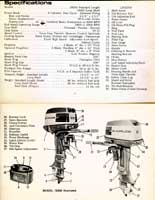 |
1973 18 was just about the end of the line after 16 years of 18's |
|
From the mid-to late '60s Johnson (but not Evinrude) marketed a 20 hp engine
but as far as I can tell it was merely a re-labled 18.
If you are willing to accept a little less than 18 horsepower, the '55 and '56 J. and E. 15's are good
engines, with the note that the 1955 used a weaker recoil starter design than the
1956, and both used the pressure tank. I would not recommend a 15 earlier than
1955 for the cheap power seeker; there are a number of differences in the earlier motors.
The Gale 15 hp outboards of the late '50s up through 1963 (the last year of Gale production)
are very good engines if the horsepower is right for your application.
Through-out the late '50s and into the '60s, OMC had kind of a "hole" in it's
outboard horsepower line; the next step up in horsepower from an 18, disregardlng
the "over-stressed" 22 cubic inch 25 hp introduced in 1968, was the much heavier
and physically larger "Big Twin." In 1957, the first year of 18 production, the big twin
was 35 hp. In 1960 it went to 40 hp. This left quite a gap in horsepower. In an attempt
to fill that gap, OMC brought out 28 and 33 hp engines in the early/mid '60s. Although these
engines filled the "horsepower gap," they were based on the Big Twin design and
were the same physical size and weight as the big twins. And anyway, any of the
the 28's, 33's, or 40's would be way too much power for the Dory.
| 1971 25 hp was basically just an ordinary 22-cubic inch 18 that
was "wound-up a little tighter." I don't see too many of these 25's
around, but if you find one in decent condition, it will be about
the lightest, most compact 25 hp package you are going to
find. Just don't count on it to pump out that 25 hp for long
periods of time. |
 |
|
Another concern, at least here in the U.S.A., is that often a person's homeowner's
liability insurance will cover a powerboat with no more than 25 hp; if you want
a larger engine, a separate insurance policy will probably need to be
purchased for the boat, as would be needed if you wanted damage and theft
coverage in addition to liability coverage.
Early Big Twins, dating from 1950 to 1955, where 25 hp and also a bit lighter (not
much) than the later big twins, but these engines are a bit older than I would
recommend for the cheap power seeker, with the possible exception of the
1955 25 hp which is a good solid engine but virtually no lighter or smaller than
the succeeding 30 and 35 hp Big Twins.
 |
Gale made a 25 hp version of the Johnson and Evinrude
"Big Twin" that was similar to the 35 hp version shown
here. the Gale 25 would be heavier and bulkier than the
25 hp version shown in the previous illustration, but
would also be a more "robust' engine.
|
|
One alternative might be a late '50s / early '60s Gale 25, a derivative of the Big
Twin design. A 25 Gale with manual start (no electric starter) would not be
too difficult to hand start (actually none of the Big Twins are THAT hard to
hand start) and the weight savings from forgoing the electric starter would be
significant. One comment; one often hears people talk of "heavy old outboards;"
these old outboards are actually no heavier, and often lighter, than modern
2-cycle outboards of the same horsepower, and are considerable lighter
than modern 4-cycle outboards. They are, however, often physcially larger than
modern engines, giving the appearance of great weight, an appearance that can
be deceiving.
If I were building a Clarence River Dory, my choice would be a 15 inch version
of the OMC 18 hp for most uses; if I expected to operate the boat very heavily
loaded, I might look for either a 1955 25 hp manual start OMC and convert it
to use a fuel pump (easy to do on a Big Twin) or possibly a 25 hp Gale, which
would already have the fuel pump.
| Transom mounting dimensions straight from the owner's
manual for the '57 18 hp Johnson. |
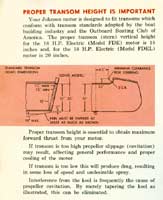 |
|
Anyway, that's my opinion.
And I always have one.
Max
|
|
|

